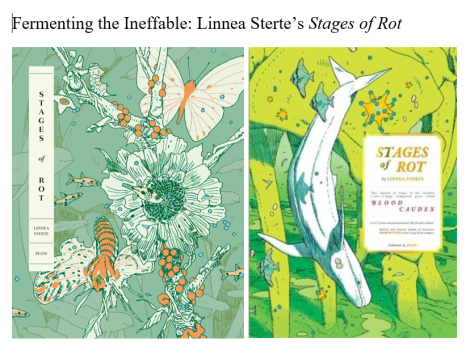Fermenting the Ineffable

I will be presenting my paper “Fermenting the Ineffable: Linnea Sterte’s Stages of Rot” at the “Fermentation and Literature” conference held at Saint Louis University in Madrid later this week. It’s the first conference I know of that includes a thematically relevant visit to a brewery and winery.
The Call for Papers was also delightful:
“The 1516 German Purity Law (Reinheitsgebot) limited the ingredients of beer to barley, hops, and water. Yet, this restriction overlooks the invisible and essential agent behind fermentation: yeast. Only centuries later was yeast recognized as the microorganism that drives fermentation. Prior to its discovery, fermentation was often attributed to divine or spontaneous forces, with no understanding of the microbiological agents at play.
“Fermentation, however, extends far beyond yeast and beer. It is an alchemical process that transforms ingredients—grapes into wine, milk into cheese, or cabbage into sauerkraut—catalyzed by a range of organisms. Yeasts, molds, and bacteria work behind the scenes, shaping the flavors and properties of food and drink, while simultaneously altering how humans understand biology, culture, and society.
“In science, yeast has become one of the most widely used “model organisms,” employed across fields from genetics to synthetic biology. Its simplicity makes it indispensable in research, yet its identity as a specific fungus is often downplayed in favor of its utility. Despite its ubiquity in laboratories, yeast remains in the scientific background, a cellular factory rather than a subject of study in its own right. This anonymity mirrors the history of fermentation’s agents, often seen as natural or given, rather than as integral co-producers.
“Beyond biology, fermentation’s transformative process has been mythologized across cultures. From ancient brewing traditions to modern artisanal movements, fermentation is both practical and symbolic. It holds the power of transformation—not only of ingredients but of perceptions, as seen in the rise of slow food, fermentation festivals, and the ongoing rediscovery of pre-industrial methods.
“In the wake of the fungal turn, led by thinkers like Anna Tsing and Merlin Sheldrake, much attention has been given to mycorrhizal fungi and their capacity to interconnect ecosystems. However, the role of fermentation and its agents, particularly yeasts and bacteria, has been underexplored in both scientific and cultural analysis. Fermentation’s potential lies in its capacity to catalyze new ideas—how might fermentation as a process or metaphor reshape how we think about symbiosis, transformation, and agency in the Anthropocene?
“This CFP invites contributions that address the scientific, cultural, and metaphorical roles of fermentation and its agents in society. Topics might include:
– The hidden histories of fermentation’s agents in brewing, food, and medicine
– Yeast and bacteria as tools or metaphors in scientific inquiry
– The role of fermentation in sustainable food systems and climate change solutions
– Cultural representations of fermentation in literature, film, or art
– The intersections of fermentation, human health, and biotechnology
– Historical and contemporary myths surrounding fermentation and its agents
“We invite contributions from scholars, scientists, writers, and artists interested in exploring the role of fermentation and its agents across fields.”
I suspect I’m the only comics scholar to submit an abstract:
“Fermentation is a kind of decay or rot caused by microscopic organisms breaking down larger organic matter. Graphic novelist Linnea Sterte offers a new mythology for that process that radically alters the role of humans and challenges a wide range of fundamental narrative norms. Stages of Rot is set on an Earth-like world where impossibly massive whales swim weightlessly in an atmosphere far above a vegetation-less landscape. When a whale descends in death, the comparatively microscopic organisms waiting to break down its body are not yeast or bacteria, but humans, a whole culture predicated on such events. A mold- and mushroom-filled “forest without trees” blooms in the carcass landscape, the home of the next culture centuries later. It too is soon replaced by later evolutionary stages of lifeforms and civilizations, until the novel’s final protagonists rediscover the whale’s heart and reanimate the possibly divine being inside it. Despite its negative connotations, decay can be a beneficial transformation, understood as a mysterious and even ineffable process. Sterte’s story captures that transformative quality not just in its narrative events but in the deeper qualities of her storytelling. Sterte’s depiction is striking for its lack of words and therefore reliance on image sequences to communicate its complexities. Rather than merely illustrating the narrative, the artwork composes it. As a result, concepts that require verbal language are rendered irrelevant in the novel’s millennia-long scope. Words cannot capture the narrative’s literally ineffable meaning. Sterte’s application of the comics form is a unique visual translation of the inherently alien yet spiritual nature of transformative decay.”
I often post my paper slides without commentary, and in this case, that “ineffable” approach is thematically appropriate.


























Chris Gavaler's Blog
- Chris Gavaler's profile
- 3 followers



